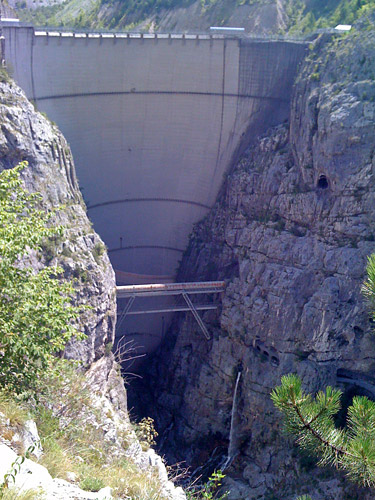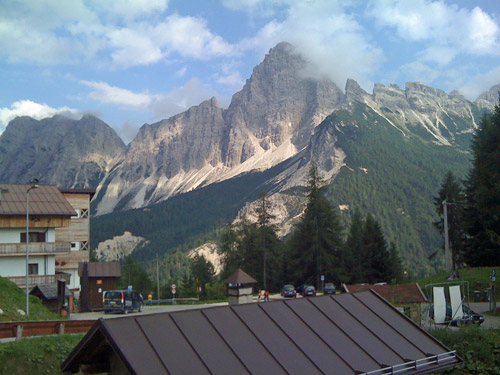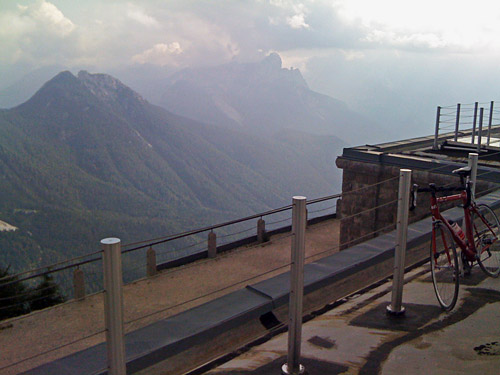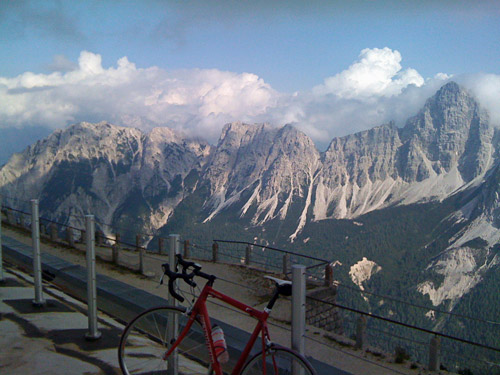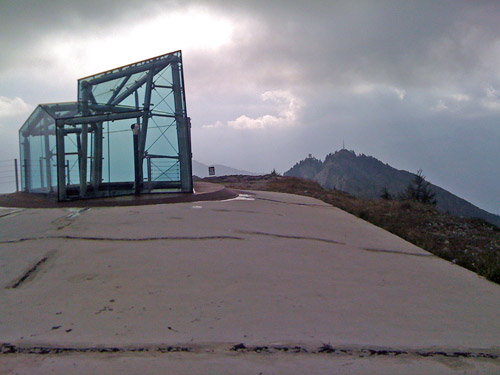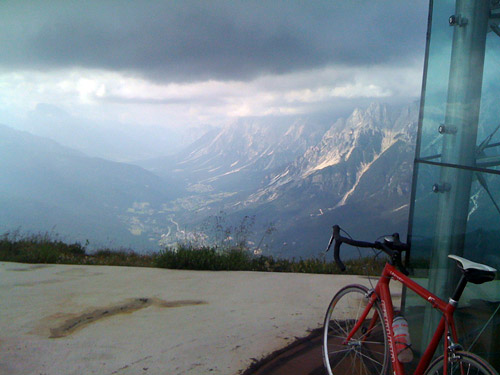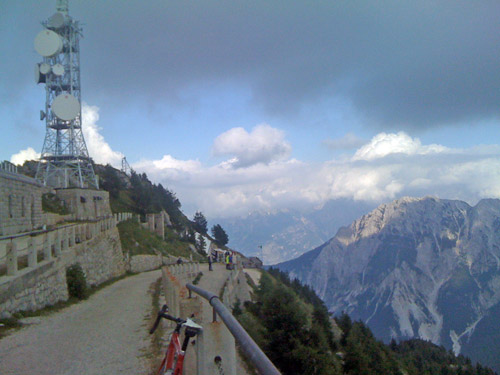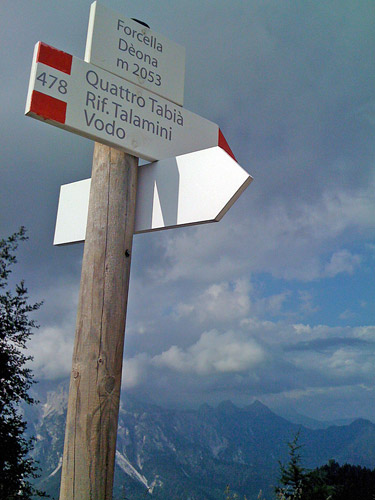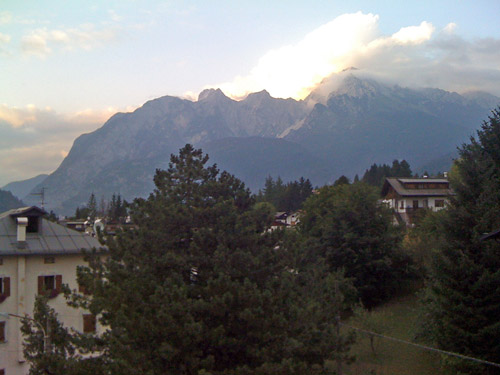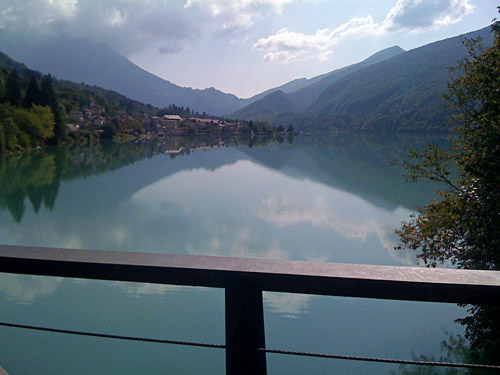
This day I got very tired again eventually and even though I got to one of my goals for the tour, this was not one of the better days. I spent almost all day and still did not do very much climbing or distance compared to most other days. I was simply not quite back in shape after the Monte Grappa Challenge yet. Anyway, it was a nice day with many great views (many photos down the page!).
I started with a very nice downhill ride to Bàrcis perhaps a little late in the morning as I already met an older man coming up from Bàrcis on the beginning of the descent. I had just gotten into the Friuli-Venezia-Giulia region from Veneto, but was now going back again for the day. Down at the quite nice lake at Bàrcis (406m) I crossed on a narrow bridge, not used by cars, I believe. I had originally planned go east here and over Forcella di Pala Barzana (840m) and Passo/Forcella di Monte Rest (1060m), but now had changed the plan so I went up (instead of down) the valley to Passo di Sant’Osvaldo (828m). It is really very nice on this stretch with very few places where people live and then not many.
I stopped on the way at S. Floriano (646m) for water and another photo. The only climb from this side is a few easy serpentines at the end and then you are up at the pass. It is nice on the other side of this pass too and lower down you come to the infamous Diga del Vajont (the dam building was completed in 1959). In 1963 ca. 2000 people in the Piave valley when the Monte Toc fell apart and fell into the dam that created a huge wave of water destroying most in its way down in Longarone and below in the Piave valley. People apparently had good reasons to be critical of how the project had been carried out and the aftermath in how compansations were handled. The road is cut into the mountain and goes through some tunnels where it goes down from the dam.
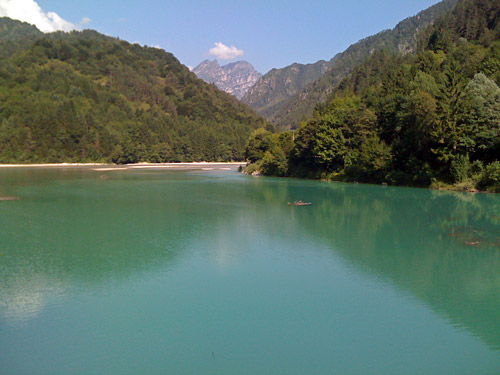
I was not looking forward to getting down the Piave valley as it was hot down there. I found a local grocery just after Longarone (440m) before they closed for lunch and had a sandwich and coca-cola (I believe). Then I took the main road through some tunnels (which is nice when it is hot), but there are alternative roads for cyclists at some (or all) of the tunnels. Then I went off the road (per my planning) to Perarolo di Cadore. At Perarolo di Cadore (which looked a bit like an abandoned village) the road continues up the side of the mountain ahead, but a sign suggested it was closed, so I took the other road back up to the main road and then had to cross the somewhat new and big bridge up here. From the bridge I could see the other road and it looked like it was passable and I think I even saw cyclists on it and a car, so I did not earn much by that detour.
At Valle di Cadore (874m) I looked after a café or shop to stop by, but found nothing. I went down to start the climb up to Forcella/Passo Cibiana (1534m) from Venas di Cadore (774m). After a little bit of climbing I came to the village Cibiana di Cadore and here I found a café/bar and so I stopped even though it was on the way up this climb. Now, if you have read my earlier tour reports, you know that I have already been to the Cibiana pass, so why would I want to go here again even if I now climb it from the other side? It is not even a pass over 1600 metres. Well, I had heard since long about a gravel road up from the Cibiana pass and not so long ago also found a description of this climb by a spanish guy (on an Italian forum) who had been cycling all the way up on his road bike, so surely I could do the same? Moreover, it has a pass before the top that is over 2000m high!

I continued the climb to Forcella/Passo Cibiana (1534m) and thought it was not so difficult, maybe I was getting used to steep roads now. At the pass I quickly found the gravel road to Monte Rite and continued up there (the first few metres are asphalted). Here it started to become a quite hard climb. The gravel road was good enough for a road bike. I kept switching lanes to find the best one, but sometimes got into some looser gravel anyway. The many hairpin bends are tight and I was almost loosing balance when taking one of these curves. There are also a few vehicles passing by taking visitors up to the museum at the top of Monte Rite, which has an old military installation. There is one unlit tunnel, but that is also no problem as it is quite short. The problem is the relentlessly steep gravel at a little over 9% on average for nearly 7 km from the Cibiana pass.
When I finally reached the museum at the top I got a little applause by some visitors seeing me coming up there. What is particularly nice here is that one can get up on the roof of the museum to have a 360 degree views around – a view that is hard to match from any destination reachable with a road bike. Some photos were taken (I wished that I had a better camera than my poor old iPhone here). It was a lovely weather and I felt better now again. Unfortunately I had to cancel several of my planned climbs in the area, like the nearby Forcella Ciandolàda (1565m), which is a wooded alternative pass to the Cibiana pass, but with a short gravel section on the top and an extremely steep climb from the east, but this pass looked a bit boring to try and climb now when I could look down on it from the top of Monte Rite. I also had planned to go up another interesting road from Lozzo di Cadore to Marmarole/Pian dei Buoi (1810m) on a regulated narrow serpentine road (gravel at the top only), but decided that I was a bit too late there for enjoying this climb when I later came to Lozzo.
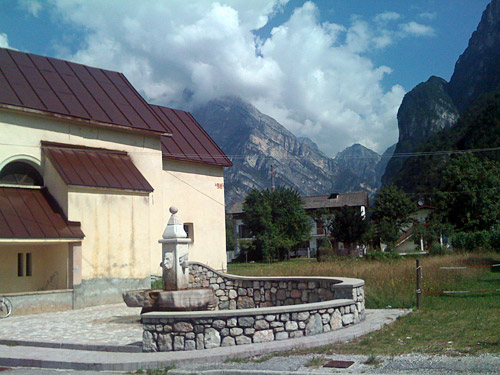
On the way down from Monte Rite I stopped at the first hairpin to take a photo of the pass sign for Forcella Rite/Deona (2055m). After lots of braking and aching hands, I got down to the Cibiana pass again and took the same way back to Valle di Cadore and then continued to Lozzo di Cadore (753m), where I decided to continue to Lorenzago di Cadore (883m) and stop there for the night and hoped to do a more ambitious day of cycling the next day again.
I went through the small town (apparently it is a town, but like a village) and stopped at the biggest hotel, Hotel Trieste, which was “interesting” too quote a commentator on the Internet. The hotel looks quite old and everything in it looks old, but as I like these types of hotels best, I was delighted. However, the food served came as a bit of surprise and I was not clear on whether this was what people around here were expected to eat or not. Others seem to eat on and be happy, but the food was not much else than a thin soup and something else that I cannot remember. Very spartan. I had a beer and ice cream afterwards in the bar, but should perhaps have gone to find a place serving a pizza or something else. I had a photo taken from my apartment, which had a decent view and slept well.

